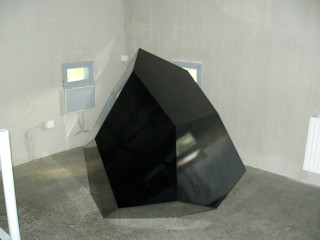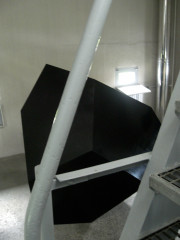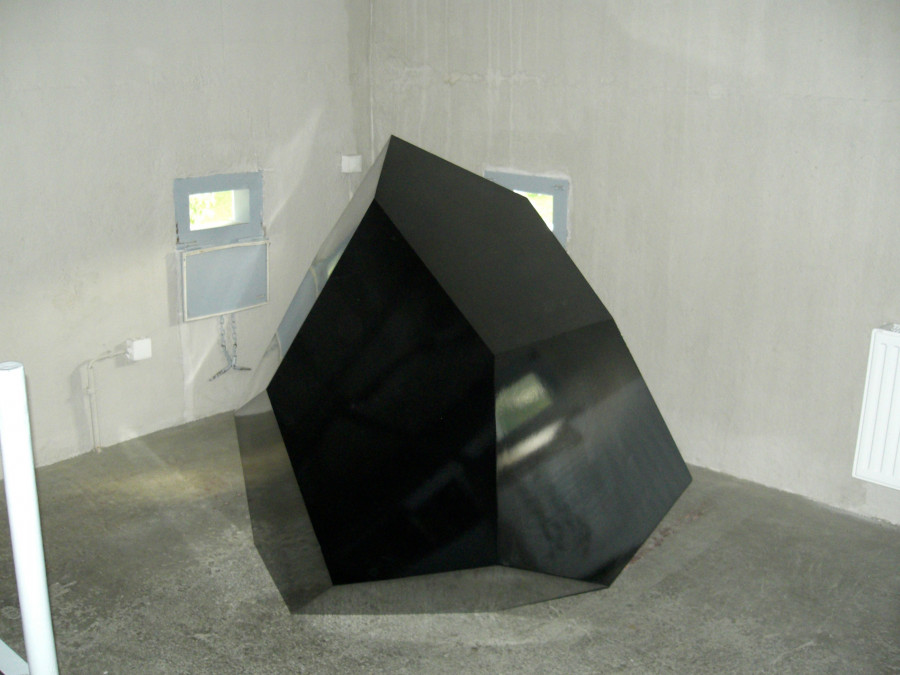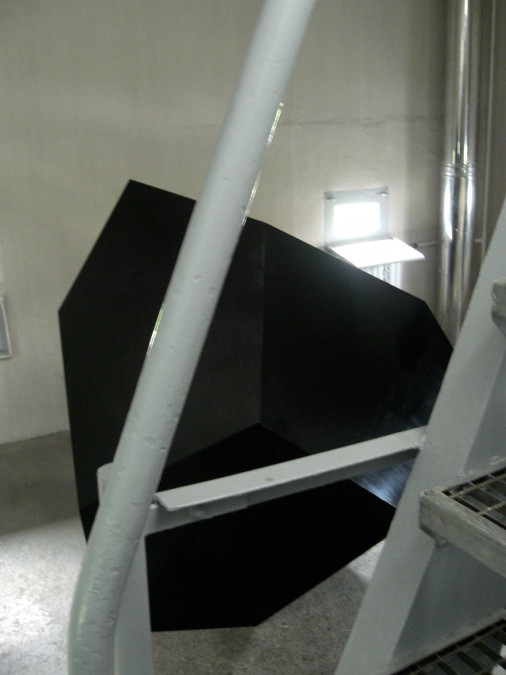Pavillon Nocturne / Letzte Überprüfung
2006
Tetraedric Pentagondodecaeder
MDF, plastic foil
150 x 150 x 150 cm
Grenzwachturm Schlesischer Busch, Berlin
Tina Born has designed a crystalline object for the windowless room on the first floor of the former border guard tower, which is only equipped with loopholes, an irregular dodecahedron with a smooth, shiny surface that reveals nothing about its inner nature. In the confined space, its presence raises questions, first and foremost about how it got in.
With its girth, the body is too large for the openings through which one enters the room. The hard, reflective black of its surfaces, which reflect the light, not only makes it appear as a foreign body, but also gives it the aura of slumbering power, capable of violating the skin of the architecture surrounding it with its sharp edges. The form thus not only irritates the viewer, it also represents an irritation of the architecture, comparable to a painful confinement, a crystalline form that matures in an organism until, having grown larger, it creates permanent friction and pain, possibly even leading to the collapse of its surroundings.
In its elusive form, natural on the one hand, the subject of complex mathematical calculations and scientific speculation on the other, the dodecahedron has always exerted a strong fascination on people. The associations aroused by the polyhedron composed of twelve pentagons were and are manifold. There are famous examples in the history of art, such as Dürer's copperplate engraving "Melencolia I" from 1514, various drawings by M.C. Escher or Salvador Dali's painting "The Last Supper". In the 20th century, it haunted science fiction literature and films as a magic stone of mostly extraterrestrial origin. Common to all occurrences is the fascination for a still enigmatic body, which for Platon embodied the universe as the fifth platonic body. In 2003, a French-American research team put forward the thesis that the shape of the universe corresponds to a self-contained dodecahedron, thus bringing the theory of the ancient scientist up to date - even if the thesis has not yet been proven.
In the tower, the spatial narrowness forces the visitor to push close to the black body. Contact is unavoidable. It is also unavoidable that the smooth surfaces play with his reflection. This circumstance can be understood as a direct iconographic reference: Dürer's famous dodecahedron in "Melencolia I" contained a secret that was not revealed until the early 1930s. Art historians discovered a portrait, perhaps a self-portrait by Dürer, in the light shadow on one of its surfaces. Giacometti drew on this discovery when, in 1934, he also created the bronze "The Cube", a dodecahedron form in which he engraved a flat, almost invisible self-portrait. The sculpture, to which he also gave the title "Pavillon Nocturne", reveals a confusing understanding of space, in which the small form is simultaneously inside and outside, excluding and including, head and space.
With the title "Pavillon Nocturne" Born plays with the double interpretation: the reference to Giacometti's work and the possibility of interpreting the dark past of the watchtower, which has meanwhile become inoperable and is surrounded by a park landscape, as a "nocturnal pavilion".
Text by Svenja Moor, 200



